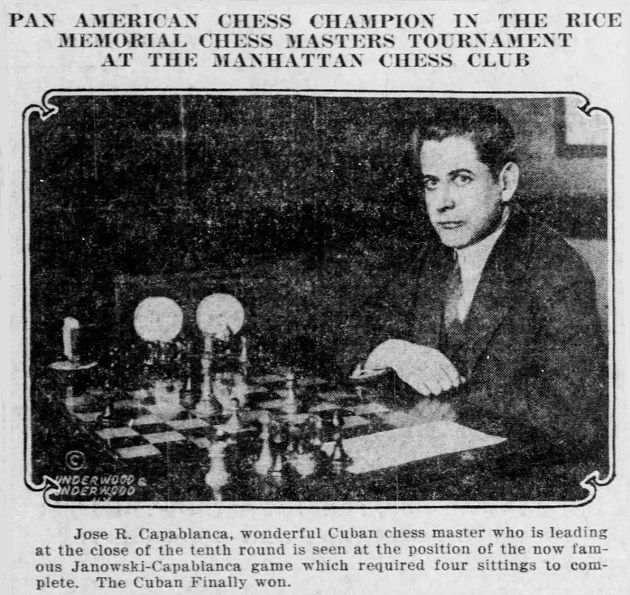
A Century of Chess: New York 1916
Another tournament with Capablanca at his height. The organizing committee invited a string of European masters, most of whom, unsurprisingly, did not respond, although somehow both Janowski and Borislav Kostic shipped across the Atlantic to be there. Marshall was absent with a stall in negotiations, as was Jaffe, who had landed on Capablanca’s black list. Capablanca won without any difficulty whatsoever.

The tournament was organized on the same lines as St Petersburg 1914 - with a preliminary round and then a final round featuring the carryover scores of the top finishers. In the preliminary round, Capablanca won 12 out of 14 games, ceding only two draws - raising the possibility that he could be exempted from the final and win the tournament regardless.
In the final, though, he made things interesting, losing a complex struggle to Chajes.
That put Janowski in a position to catch him with a win, but Capablanca outplayed him and took the tournament by three full points.
The loss to Chajes reset Capablanca’s record of thirty games without a loss. After that defeat, he went eight years, and sixty games, before his next loss.
And here is the brilliancy prize winner, Janowski's win over Chajes.
It's worth saying a word about Isaac Rice, the tournament's sponsor and for whom it was named. Rice was an interesting guy. He trained as a musician and then as a lawyer. He made a fortune investing in railroad lines and then in electric storage. But his real wealth came from his pioneering work with submarines. He was awed by the work of John Holland, an eccentric inventor, bought Holland’s company (which had originally been funded by the Fenians, the Irish revolutionaries), and brought his invention to scale. Rice secured a contract with the U.S. Navy and became, essentially, one of the world’s leading arms dealers - becoming the major supplier of submarines to the U.S. Navy in the lead-up to World War I but selling also to Japan and Russia during the Russo-Japanese War and to countries as far-flung as Greece, Italy, and Peru. After his death, Holland would receive acclaim for being the true “inventor of the modern submarine” - and Rice would be tarred as something of a villain for a spat the two had in the 1900s and which led to Holland’s getting largely airbrushed out of the history. Ironically, the two would die within a year of each other - Holland in 1914, Rice in 1915, just as submarine manufacturing was taking off during World War I and the Holland submarine was becoming, really, the international standard.

Though a man of parts, Rice had really only one passion - which was chess. He was the very epitome of the eccentric chess patron - living in his soundproof mansion on Riverside Drive, with his mysterious sources of wealth (at the time, submarine investment would have been difficult to differentiate from foolhardiness), and plowing money into chess events. Rice became famous above all for his sponsorship of the Rice Gambit - a line in the King’s Gambit Accepted in which white sacrifices a piece on move eight. Edward Winter writes that mention of the Rice Gambit is now “accompanied by an almost mandatory sneer,” but it actually held up well in an extensive trial in the Rice Gambit tournament of 1904, with white scoring +2 in top-level competition.

Rice was the financial backbone of U.S. chess in the early part of the 20th century, and there’s a case to be made that, after his death, chess in America didn’t recover until the Fischer era. He was the president of the Manhattan Chess Club and, upon his passing, had the Progressive Chess Club named after him. “He had one final goal,” as Andy Soltis writes - to sponsor an American chess tournament that could rival St Petersburg 1914. That was what New York 1916 was meant to be, but Rice died a few months before it was held - and the war (and the impact of submarine warfare on transatlantic shipping) prevented the tournament from fulfilling all of Rice’s ambitions. Still, the tournament was named in his honor and, under the circumstances, was a nice send-off for the most devoted patron of the era.

Crosstable of preliminaries: 
Crosstable of final scores: 
Sources: Capablanca annotates two of his games in My Chess Career. Isaac Rice is discussed in this article about inventions, in this history of the Electric Boat Corporation, in Edward Winter's article on his chess contributions, in batgirl's excellent piece on him. There's contemporary discussion of the tournament in The Chess News. Andy Soltis reflects on it in Frank Marshall: U.S. Chess Champion.